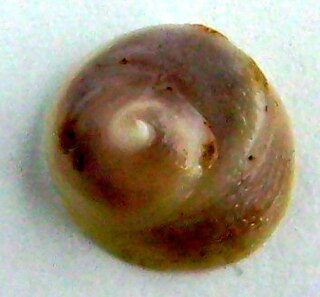
An egg is an organic vessel grown by an animal to carry a possibly fertilized egg cell and to incubate from it an embryo within the egg until the embryo has become an animal fetus that can survive on its own, at which point the animal hatches.

A veliger is the planktonic larva of many kinds of sea snails and freshwater snails, as well as most bivalve molluscs (clams) and tusk shells.

Crepidula fornicata is a species of medium-sized sea snail, a marine gastropod mollusc in the family Calyptraeidae, the slipper snails and cup and saucer snails. It has many common names, including common slipper shell, common Atlantic slippersnail, boat shell, quarterdeck shell, fornicating slipper snail, Atlantic slipper limpet and it is in Britain as the "common slipper limpet".

Urosalpinx cinerea, common name the eastern oyster drill, Atlantic oyster drill, or just oyster drill, is a species of small predatory sea snail, a marine gastropod mollusk in the family Muricidae, the murexes or rock snails.

The Calyptraeidae are a family of small to medium-sized marine prosobranch gastropods.

Spawn is the eggs and sperm released or deposited into water by aquatic animals. As a verb, to spawn refers to the process of freely releasing eggs and sperm into a body of water ; the physical act is known as spawning. The vast majority of non-mammalian, non-avian and non-reptilian aquatic and/or amphibious lifeforms reproduce through this process, including the:

Crepidula, commonly known as the slipper snails, slipper limpets, or slipper shells, is a genus of sea snails, marine gastropod mollusks in the family Calyptraeidae. This family includes the slipper snails (Crepidula), hat snails (Calyptraea), spiny slipper snails (Bostrycapulus), and cup-and-saucer snails (Crucibulum) as well as Crepipatella, Siphopatella, Grandicrepidula, and Maoricrypta.

Crepipatella is a genus of sea snails, marine gastropod mollusks in the family Calyptraeidae, the slipper snails and cup-and-saucer snails.

Cymbiola nobilis is a species of sea snail, a marine gastropod mollusk in the family Volutidae, the volutes. The snail's shell is commonly collected in the sea shell trade, which has resulted in overharvesting of the snail.

Calyptraea chinensis, common name the Chinese hat snail or Chinese hat shell, is a species of small sea snail, a marine gastropod mollusk in the family Calyptraeidae, the slipper snails or slipper limpets, cup-and-saucer snails, and Chinese hat snails.
Crepidula atrasolea is a species of small sea snail, a slipper snail, a marine gastropod mollusk in the family Calyptraeidae, the slipper snails or slipper limpets, cup-and-saucer snails, and hat snails.
Crepidula badisparsa is a species of sea snail, a marine gastropod mollusk in the family Calyptraeidae, the slipper snails or slipper limpets, cup-and-saucer snails, and Chinese hat snails.

Crepidula convexa is a species of sea snail, a marine gastropod mollusk in the family Calyptraeidae, the slipper snails or slipper limpets, cup-and-saucer snails, and Chinese hat snails. The maximum recorded shell length is 20 mm.
Crepidula depressa is a species of sea snail, a marine gastropod mollusk in the family Calyptraeidae, the slipper snails or slipper limpets, cup-and-saucer snails, and hat snails.

Crepidula plana, common name the eastern white slippersnail, is a species of sea snail, a marine gastropod mollusk in the family Calyptraeidae, the slipper snails or slipper limpets, cup-and-saucer snails, and hat snails. This species is characterized by a flat white shell, a white body, and development that includes a planktotrophic larval stage. This species often occurs inside large gastropod shells that are inhabited by hermit crabs. In this case the shells are often extremely flat, and often recurved.
Crepidula ustulatulina is a species of small sea snail, a slipper snail, a marine gastropod mollusk in the family Calyptraeidae, the slipper snails or slipper limpets, cup-and-saucer snails, and Chinese hat snails.

Crepipatella dilatata is a species of sea snail described by Lamarck. It is a marine gastropod mollusk in the family Calyptraeidae, the slipper snails or slipper limpets, cup-and-saucer snails, and hat snails.
Limacina retroversa is a distinct species of swimming planktonic gastropods, belonging to a group of predatory sea snails known as sea butterflies (Thecosomata). The name Limacina retroversa describes the unique morphology of this sea snail, including its slug-like body and coiled, backwards-turning shell. They are typically found in the epipelagic zone of cold, polar waters, but can be found worldwide, in any ocean. L. retroversa are currently under threat, as their numbers are decreasing due to rising global carbon levels and other human-caused climate threats.

Sinistrofulgur sinistrum is an edible species of large predatory sea snail in the family Busyconidae, the busycon whelks.
Thyonicola americana is a species of parasitic sea snail, a marine gastropod mollusc in the family Eulimidae. It infests the sea cucumbers Eupentacta quinquesemita and Eupentacta pseudoquinquesemita in Puget Sound and other parts of the northeastern Pacific Ocean.














